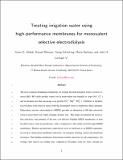Treating Irrigation Water Using High-Performance Membranes for Monovalent Selective Electrodialysis
Author(s)
Ahdab, Yvana Daniella; Rehman, Danyal; Schücking, Georg; Barbosa, Maria; Lienhard, John H
Downloadfujifilm_paper_cutsections.pdf (996.9Kb)
Open Access Policy
Open Access Policy
Creative Commons Attribution-Noncommercial-Share Alike
Terms of use
Metadata
Show full item recordAbstract
The most common desalination technology for treating brackish irrigation water is reverse osmosis (RO). RO yields product waters low in monovalent ions that are harmful to crops (Na⁺ and Cl⁻) and in divalent ions that encourage crop growth (Ca²⁺, Mg²⁺, and SO₄²⁻). Fertilizer or divalent-rich brackish water must be mixed with the desalinated water to reintroduce these nutrients. Monovalent selective electrodialysis (MSED) provides an alternative to RO that selectively extracts monovalent ions while retaining divalent ions. This paper investigates the monovalent selectivity and potential of the new cost-effective Fujifilm MSED membranes to treat brackish source water in greenhouses, with a comparison to the widely used Neosepta MSED membranes. Thirteen groundwater compositions serve as feedwater to an MSED experimental setup to characterize membrane selectivity, ion transport, limiting current, and membrane resistance. The Fujifilm membranes demonstrate notable selectivity for all compositions. On average, they remove six sodium ions, compared to Neosepta’s four, for every calcium ion and 13 sodium ions, compared to Neosepta’s seven, for every magnesium ion, while their bench-scale cost is 68% lower than that of the Neosepta membranes. The Fujifilm selectivity values are used to calculate annual fertilizer savings of MSED relative to RO, which average $4995/ha for 6000 brackish groundwaters across the United States.
Date issued
2020-09Department
Massachusetts Institute of Technology. Department of Mechanical Engineering; Rohsenow Kendall Heat Transfer Laboratory (Massachusetts Institute of Technology)Journal
ACS ES&T Water
Publisher
American Chemical Society (ACS)
Citation
Ahdab, Yvana D. et al. "Treating Irrigation Water Using High-Performance Membranes for Monovalent Selective Electrodialysis." ACS ES&T Water (September 2020): doi.org/10.1021/acsestwater.0c00012 © 2020 American Chemical Society
Version: Author's final manuscript
ISSN
2690-0637